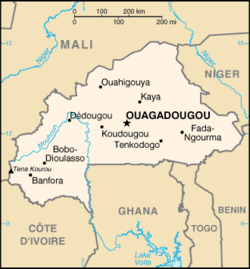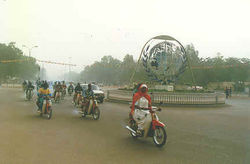Ouagadougou
2007 Schools Wikipedia Selection. Related subjects: African Geography
Ouagadougou ( IPA: [wɑgədugu]} is the capital of Burkina Faso. It is the country's largest city, with a population of 960,116 ( as of 2000) and is the administrative, communications, cultural and economic centre of the nation. The city's name is often shortened to Ouaga.
Ouagadougou's primary industries are food processing and textiles. Ouagadougou is served by an international airport, rail links to Abidjan in Côte d'Ivoire and to Kaya in the north of Burkina, and a highway to Niamey, Niger. Being such a focal point, there are many cinemas, nightclubs, and French, American and Zaka cultural centres. Ouagadougou is the site of Ouagadougou Grand Market, one of the largest markets in West Africa. Other attractions include the National Museum of Burkina Faso, the Moro-Naba Palace (site of the Moro-Naba Ceremony), the National Museum of Music, and several craft markets.
History
Ouagadougou is the capital of Burkina Faso. Burkina Faso was called the Republic of Upper Volta when it gained independence from France in 1960. It was renamed Burkina Faso by Thomas Sankara in 1984. The name Ouagadougou goes back to the 15th century. At that time, two different tribes, the Yonyonse and the Ninsi, inhabited the area. They were in constant conflict. This ended in 1441 when Wubri, a Yonyonse hero and an important figure in Burkina Faso’s history, led his tribe to victory. He then renamed the area from “Kumbee-Tenga”, as the Ninsi had called it, to “Wogodogo”, meaning "where people get honour and respect." Ouagadougou is a corruption of Wogodogo. The spelling of the name Ouagadougou is derived from the French orthography common in former French African colonies. If English orthography were used (as in Ghana or Nigeria), the spelling would be Wagadugu.
Geography
Ouagadougou, situated on the central plateau (12.4° N 1.5° W), grew around the imperial palace of the Mogho Naaba. Being an administrative center of colonial rule, it became an important urban center in the postcolonial era. Simultaneously the capital of the Mossi Empire and of Burkina Faso since 1947, Ouagadougou became a veritable communal centre in 1995.
Government
The first municipal elections were held in 1956. Ouagadougou is governed by a mayor, who is elected for a five year term, two senior councilors, and ninety councilors.
The city is divided into 5 districts, consisting of 30 sectors. Districts of Ouagadougou include Gounghin, Kamsaoghin, Koulouba, Moemmin, Niogsin, Paspanga, and Peuloghin and Tiendpalogo. Seventeen villages comprise the Ouagadougou metropolitan area, which is about 219.3 km². The population of this metropolitan area is estimated to be 1,200,000 inhabitants, consisting of 48% men and 52% women. The rural population is about 5% and the urban population about 95% of the total, and the density is 6,249 inhabitants per square kilometer, according to 1997 statistics.
Concerning city management, the communes of Ouagadougou have made the decision to invest in huge projects. This is largely due to the fact that Ouagadougou constitutes a 'cultural centre' by merit of holding the SIAO (International Arts and Crafts fair) and the FESPACO (Panafrican Film and Television Festival of Ouagadougou). Moreover, the growing affluence of the villages allow for such investment, and the fact that the population is growing rapidly necessitates it.
Climate
The climate of Ouagadougou is rather hot. The town is part of the Soudano-Sahelian area with a rainfall of 750 mm per year. The rainy season stretches from May to October with an average temperature of 30 °C. The cold season stretches from December to January, with a minimum temperature of 19 °C. The maximum temperature during the hot season, which runs from April to May, is 40 °C. The Harmattan (a dry wind) and the Monsoon represent the two main factors which determine the climate of Ouagadougou.
Tourism
Ouagadougou and its neighborhoods are very attractive places. There are a number of great places worth visiting.
Parks
A well-known site in Ouagadougou is the Bangr-Weoogo urban park (area: 2.63 km²). Before colonialism, it belonged to the Mosse chiefs. Considering it as a sacred forest, many went there for traditional initiations or for refuge. The French colonists, disregarding its local significance and history, established it as a park in the 1930s. In 1985, the park was started its renovations. In January 2001 the forest was renamed “Parc Urbain Bangr-Weoogo”, meaning "the urban park of the forest of knowledge." Because of the many changes, new regulations have been put in place along with a new set of objectives for the park.
Another notable park in the capital city is the “ L’Unite Pedagogique” which shelters animals in a semi-freedom state. This botanic garden/biosphere system stretches out over 80,000 m², and also serves as a museum for the country’s history.
Other sites
Apart from the parks, Ouagadougou has a great number of places of interest, such as monuments:
- “ Naba Koom” is a statue depicting a woman handling a calabash to pour water. The statue is 6 m high and faces the railroad station, welcoming travellers into Ouaga. The place bears the name of an important Chief in Burkina-Faso’s history.
- “ Jardin de l’amitie Ouaga-Loudun” (Garden of Ouaga-Loudun Friendship), with a green space that was renovated in 1996, is a symbol of the twin city relationship between Ouagadougou and Loudun in France. It is situated in the centre of the town, near the “ Nation Unies’crossroads”.
- “La Place du Grand Lyon” is the respective monument to reflect the relationship between Burkina-Faso’s capital and Lyon in France. It is located near the French cultural Centre George Melies, this monument shows an imposing lion.
- A zoo, called “ Parc Animalier de Ziniare”, is located 30 km east of the city, and can be included among the great tourist attractions of Ouagadougou.
- “ Musee de Manega”, 55 km northwest of the city, exhibits all the musical instruments of Burkina-Faso.
- “ Laongo”, 30 km east of the city, features enormous granite slabs that were designed by sculptors. The exhibit displays artistry from all five continents.
Social life and education
Education
Literacy in Ougadougou is not high, however, there are currently ten universities in the city. The state University of Ouagadougou was founded in 1974. The official language is French and the principal local languages are More, Dyula and Fulfulde. The bilingual programme in schools (French plus one of the local languages) was established in 1994.
Sport, culture, and leisure
A wide array of sports, including association football, basketball, and volleyball, is played by Ouagadougou inhabitants. There are sports tournaments and activities organized by the local authorities.
There are a number of cultural and art venues, such as the Maison du Peuple and Salle des Banquets, in addition to performances of many genres of music, including traditional folk music, modern music, and rap.
Art and crafts
Several international festivals and activities are organized within the municipality, such as FESPACO (Panafrican Film and Television Festival of Ouagadougou), which is Africa's largest festival of this type, SIAO (International Art and Craft Fair), FESPAM (Pan-African Music Festival), FITMO (International Theatre and Marionnette Festival) and FESTIVO.
Practical information
Hotels and restaurants
There has been a recent increase in the quality of hotels and restaurants and there now a great number of four and five star hotels available.
Health
There are both state and private hospitals. The two state hospitals in the city are the Centre hospitalier national Yalgado Ouedraogo (CHNYO) and the Centre hospitalier national pediatrique Charles de Gaulle (CHNP-CDG), but there are a large number of private hospitals and additional health infrastructure. Despite that, the local population still largely trusts more traditional local medicine and the “pharmacope”.
Transport
The citizens of Ouagadougou prefer their own motorcycles and bicycles (and more recently, cars) to public transportation. The city's automobiles are generally small and inexpensively made, using a small two-stroke cycle engine. Ouagadougou's citizens also travel in readily available green cabs, which will take their passengers anywhere in town for about 1,000 CFA. The downside is that they are slow and crowded, preferring to shuttle groups of people rather than individuals.
Ouagadougou Airport serves the area with flights all over West Africa and to Europe.
Sister cities
 Québec City, Québec, Canada
Québec City, Québec, Canada Lyon, France
Lyon, France Grenoble, France
Grenoble, France Turin, Italy
Turin, Italy San Miniato, Italy
San Miniato, Italy Leuze, Belgium
Leuze, Belgium Kuwait City, Kuwait
Kuwait City, Kuwait


